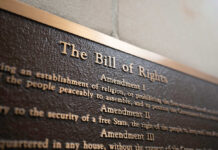
What is inalienable?
Where do rights come from and what makes them “inalienable”? The oft-quoted line that suggests that U.S. citizens have “inalienable rights” comes from Thomas Jefferson’s Declaration of Independence.
“We hold these truths to be self-evident, that all men are created equal, that they are endowed by their Creator with certain unalienable Rights, that among these are Life, Liberty and the pursuit of Happiness,” the declaration reads.
According to Merriam-Webster, something is considered “inalienable” if it is unable to be surrendered. The root of the word, “alien” denotes “belonging to another,” so to negate that means belonging to oneself.
In other words, Jefferson is saying that the rights that are given to men by his “Creator” are unable to be taken away by men. They are, undoubtedly, his own.
What did Jefferson Believe?
Any article discussing Americans’ rights is hardly complete without deferring to the original intentions and beliefs of the country’s founders. Jefferson, who popularized the phrase, strongly believed in the rights of the individual protected from a tyrannical government and the right to religious freedom.
While writing the declaration, Jefferson borrowed and modified John Locke’s idea of the natural rights of individuals, which was originally, “Life, Liberty, and Property.” Like Jefferson, Locke believed that government was subject to the people, not the other way around. He also denounced tyranny much like the American founder.
Taking from Locke, it makes sense then that Jefferson made efforts to both limit and check the power of the government by asserting that the government had no reign or mandate to revoke or rebuke the natural rights of citizens.
What are these inalienable rights and who fought for them?
Just asserting “Life, Liberty, and the Pursuit of Happiness” might not be specific enough. The U.S. Constitution does not do too much to address the rights of Americans as much as it does delineate the separate powers of the government. So, if we have a document delineating the powers of the government, where can we find a document delineating the rights of the people from that government?
That’s what the Bill of Rights is for.
James Madison, one of the founders of the United States, fought for the inclusion of the Bill of Rights and its first Ten Amendments within the Constitution. He believed that an official list of the rights enjoyed by a citizenry was as important as the Constitution itself. Madison, however, faced pushback.
On September 12, 1787, two years before the ratification of the U.S. Constitution, the delegates of the Constitutional Convention argued that states had their individual bill of rights, so a federal document would be superfluous.
But Madison continued onward for the next two years until, when on the House floor on June 8, 1789, he delivered a speech saying that the Bill of Rights would “expressly declare the great rights of mankind secured under this constitution.”
The founder, and eventual president, initially composed 19 amendments, but achieved consensus with 10, among those being the right to free speech, the right to bear arms, the right to be secure in one’s home, and the presumption of innocence.
On December 15, 1791, the Bill of Rights was ratified, cementing the “inalienable rights” of the American citizen.














